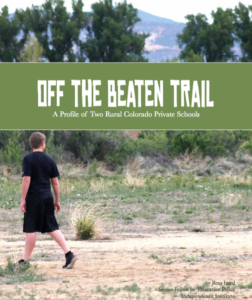Rural Colorado Needs School Choice Too

Rural towns face unique difficulties and therefore require unique solutions in their communities, and education is no exception. Why would it be? The difference in logistics, economies, and culture creates new challenges for the services of any populace. Just as any child such as myself will face a distinct set of challenges in education, so will any community in attempting to create the educational opportunities that will address its youth’s needs.
To learn more about the dynamics of education and school choice in rural communities, Independence Institute Senior Fellow Ross Izard took a road trip through western Colorado in which he visited two private schools. The story of his experience is featured in his latest profile, titled Off the Beaten Trail: A Profile of Two Rural Colorado Private Schools.
The first school featured in Off the Beaten Trail is Pope John Paul II Academy, a private Catholic school in Montrose. Pope John Paul II emphasizes a deep dedication to its community, exemplified by the fact that it has never turned down a student for an inability to pay the school’s tuition. This degree of dedication to education over finance is needed when dealing with the economies of rural towns and the accompanying challenges a limited economy can create for its constituents.
Lucky for Montrose, Pope John Paul II’s teachers and administrators, or the many staff members who double as both, are committed to supplying an alternative educational option for the parents and students of Montrose. Accordingly, they make sacrifices–such as accepting lower pay and taking on unorthodox, expanded responsibilities–so that the community does not have to.
The second school Ross visited on his journey is Holy Trinidad Academy (HTA), a private school in the old coal mining town of Trinidad. HTA’s community faces some of the same rural economic hardships as Montrose, and additionally supports many students that come from the local public schools with special needs or that are behind grade level. This combination of challenges seems daunting, yet HTA has managed to retain an average college entrance exam score above the states average and progressed ninety-percent of its students into college–an astonishing and praiseworthy feat for a school in which teachers make on average less than $20,000 per year.
There is remarkable work being done by the innovative members of rural community featured in Ross’s profile. These local education leaders are creating solutions to the distinct problems that their communities face. The hardships they face in doing so are not overlooked, but what stands out more than their difficulties is the impact that their hard work has created on their communities.